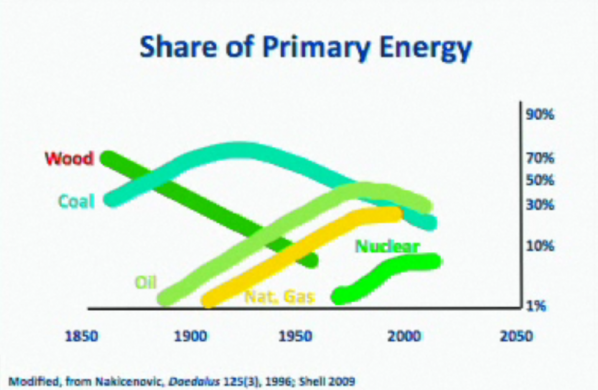Richard Sears TED Talk “Planning for the end of oil” helped put things into perspective. While energy is probably one of the slowest moving sectors to adapt, it does adapt. In Sears talk he presents a historical graph of wood, coal, oil, natural gas, and nuclear in relation to their share as our primary energy source in the last 150 years.
While renewable energy sources are not represented on this graph, I couldn’t help but imagine what the next 50 years will look like. Where will algae be on this graph? What innovation will continue this trend of decarbonizing our future energy systems?
With progressing fields of science intersecting with engineering, there are some very exciting possibilities. Last month, the J. Craig Venter Institute announced that they had made the first synthetic cell. MIT’s Technology Review (TR) reported on it today. The concept of generating synthetic genomes as a way to produce desired products is the basis behind another one of Craig Venter’s other companies Synthetic Genomics. In TR’s story they point to the current cost barrier.
“Developing these techniques took about $30 to $40 million in funding, mostly from the company Synthetic Genomics. The main cost of these experiments comes from the price of synthesizing DNA, which may go down as more researchers see the promise of these types of experiments. "Other groups aren't doing this because of the cost and because the methods have been difficult, but I'd like to think we're making the methods simple," says Daniel Gibson, associate professor at the Venter Institute. “
This high cost of synthetic biology approaches has allowed only the three best funded algae biofuel companies (Synthetic Genomics, Sapphire Energy, and Solazyme) to integrate it into their business strategy. Like everyone else, I am wondering where these companies are in their research and development? And when we will find algae on the primary energy graph?

 RSS Feed
RSS Feed
